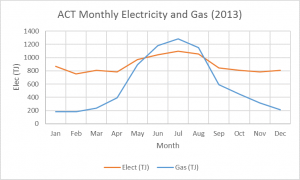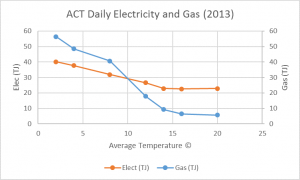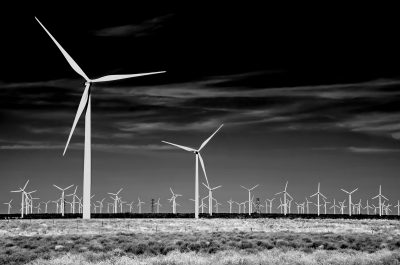How can we use gas without the emissions?
Gas is considered the cleaner of the fossil fuel as, unlike its heavier cousins oil and coal, it does not produce particulates when burned to provide energy. Still, natural gas does produce greenhouse gases. What are the most effective ways to reduce these emissions?
Gas for heating
The use of gas for heating is very seasonal with space heating generally only required in colder months. This pattern is more prominent for households and small businesses, not so much at large-scale industrial issue.
The Canberra gas network is an excellent example of how gas use rises significantly during colder months. The winter peak of 1200 TJ[i] from June to August is six times the low of 200 TJ over summer. This winter gas peak also coincides with the peak demand for electricity.

Figure 1: Monthly electricity and gas consumption in the ACT (Source: ACT Government[ii], Energy Networks Australia analysis)
Correlating gas energy use with the average daily temperature illustrates the non-surprising result that people use more gas and electricity to heat their homes on colder days. It also emphasises that nearly twice as much electricity is used on days with an average temperature of two degrees compared to warmer days of between 15 and 20 degrees.

Figure 2: Variation of energy consumption with average temperature (Source: ACT Government, Energy Networks Australia analysis)
Reducing emissions
While using natural gas to create energy creates far fewer emissions than coal, it is increasingly being recognised that it contributes to greenhouse gases, an issue that needs to be managed as we strive to meet emissions reduction targets. There are several options to consider that allow us to continue to use gas but without the emissions.
1. Offsets
Using an offset scheme (such as the Carbon Neutral Charitable Fund[iii]) indicates that a tonne of CO2 emissions can be offset for $19 (or roughly $1/GJ of gas). The average household in Australia uses 33GJ of gas per year, which produces 1.7 tonnes of emissions, so to offset these emissions would cost $32.30. Table 1 provides indicative costs for offsetting emissions from household gas use.
| State |
Average household consumption of gas (GJ) |
CO2 emissions (t) |
Costs to offset emissions ($) |
| ACT |
35 |
1.8 |
34.20 |
| NSW |
20 |
1.0 |
19.00 |
| QLD |
8 |
0.4 |
7.60 |
| SA |
17 |
0.9 |
17.10 |
| TAS |
34 |
1.7 |
32.30 |
| VIC |
49 |
2.5 |
47.50 |
| WA |
15 |
0.8 |
15.20 |
Table 1: Cost to offset emissions from household natural gas use (Source: Energy Networks Australia analysis, Carbon Neutral).
However, in the long term, it is unclear whether these schemes will continue and whether the costs to deliver such offsets will remain at current levels.
2. Electrification
No spare capacity in the network
Electrification is basically the process of removing gas appliances and installing electrical ones. As shown above, where peak demand for gas and electricity coincide during the winter months, there is little or no spare capacity in the electricity network to meet this additional demand.
This means to reduce emissions through electrification would require massive transmission and distribution electricity network upgrades, not to mention possible upgrades within homes to meet this new combined peak. The cost of upgrading the necessary infrastructure in places like the ACT would be far from a marginal increase. The existing winter electricity peak would need to grow to replace the larger existing gas usage.
Appliances are less efficient when very cold
Some argue that the efficiencies of new electrical appliances such as reverse cycle air-conditioning will reduce the growth in electricity demand. However, this efficiency does not apply on very cold days. Many of the claimed benefits and efficiencies of newer model appliances do not apply on days when average temperatures are near freezing – exactly the days when you want your heating to work and when demand is at its peak. The Canberra minimum temperature last month was minus five degrees.
3. Renewable gas
Renewable gas is a third option for reducing emissions from the use of gas in the grid. This could be biomethane, hydrogen or a blend of both.
Biomethane
Biomethane can be a direct substitute for natural gas but is sourced from biomass (e.g. food waste) instead of fossil fuel sources. The economics of biomethane being a cost-competitive fuel are largely dependent on avoiding levies for waste at landfills. Currently, when biogas is produced, it is generally converted to renewable electricity as there is a financial incentive through the Renewable Energy Target. Additional costs would be incurred before the gas can be injected into networks. There is uncertainty regarding the potential of biomethane. A recent UK report indicates that methane could only provide between 2 and 10 per cent of their domestic use of gas from biogas sources per year[iv].
Hydrogen
Renewable hydrogen[v] is another option of renewable gas. Hydrogen is a clean-burning gas that produces no carbon dioxide when used. However, due to its characteristics, converting to 100 per cent hydrogen will require updating appliances. The gas industry is familiar with transporting fuels to homes, it is familiar with ensuring safety of gas appliances and has in the last 50 years carried out a major conversion program from Towns gas to natural gas. So, while there are known challenges, industry is well placed to address them.
A common criticism of renewable hydrogen is that it is more costly than natural gas. That partly reflects that renewable hydrogen production processes are still early in their commercial development and it is expected that costs will come down significantly (similar to solar PV cells and lithium-ion batteries) over time. Hydrogen also does not produce any carbon dioxide emissions so once those emissions are factored into the cost, hydrogen will level the playing field even more.
Gas in the future
Gas demand increases significantly in colder months as it is used for heating, hot water, and cooking in the home. Simply electrifying our energy sector is not a viable option as it would require huge investment in infrastructure to accommodate the extra load on our electricity grid, particularly during cold winter months when people warm their homes and businesses.
To meet Australia’s current energy demand, the cheapest short-term low emission option is to continue to use gas and counter CO2 emissions using an offset scheme. In the longer term, other options may become available and more viable, but the blending and eventual conversion of our gas networks to hydrogen may represent the best long-term option. The network sector is preparing for this now and is looking for effective policy drivers from the government to help facilitate this long-term change.
[i] One TeraJoule (TJ) of gas provides energy for around 30 homes during a year, or in terms of typical 8.5 kg BBQ gas bottles, it represents 2,350 of those.
[ii] https://www.environment.act.gov.au/__data/assets/pdf_file/0006/711699/Electricity-and-Natural-Gas-Consumption-Trends-in-the-Australian-Capital….pdf
[iv] Source: The Institution of Engineering and Technology (2019), Transitioning to hydrogen, p10 notes UK domestic consumption is 1,000 TWh pa, while potential from biogas volumes is limited to between 20 to 100 TWh pa.
[v] Hydrogen can also be produced from natural gas or coal but then the carbon dioxide emissions would need to be managed using carbon capture and storage. This could effectively produce low carbon gas.


